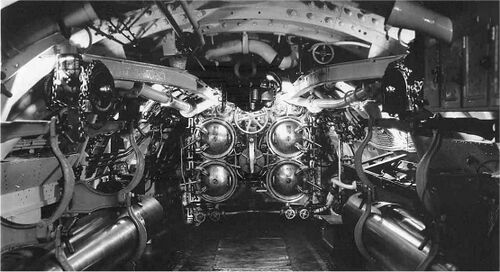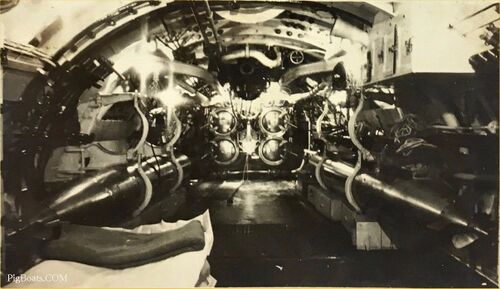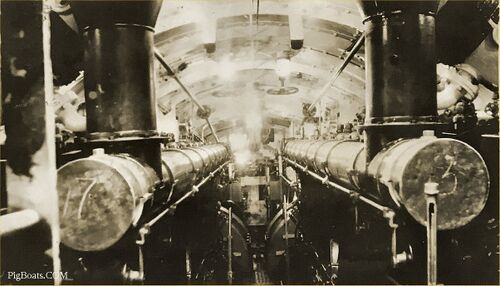H-5

The reloads were lifted by the chain-hoists shown on the near ends of the curving overhead tracks shown in the overhead of the photo and then moved into position along the track. At this time the torpedo was swinging free and would have been very difficult to control in anything other than a smooth sea. These are Bliss-Leavitt Mk 6 or 7 torpedoes.
The large wheel shown above the tubes is to turn the heavy bow cap that closed off the outer ends of the torpedo tubes. There were two openings that allowed the firing of the torpedoes. These were asymmetrical and allowed a top tube on one side and a bottom tube on the other to be fired. The cap was then rotated and the other two tubes were then able to be fired.
U.S. Navy photo.

Another photo of the torpedo room of the submarine H-5 nearly identical to the one above. Storage boxes are under the reload torpedoes. This photo was likely taken after she had been in service for a while, approximately 1919-1920. A crewman's bunk is made up at deck level in the foreground. The bunks slid under the torpedoes when not in use.
Photo in the private collection of Ric Hedman.

This photo is taken looking at the after end of the H-5's torpedo/forward battery room. The H-4 to H-9 did not have the watertight bulkhead installed between the torpedo room and the forward battery. The two rooms were actually one large compartment. The door to the left can be seen leading through the control room and the door to the after battery compartment is visible.
Seen in the center of the bulkhead are six Springfield Model 1903 (M1903) bolt action rifles. "The American Rifle" as it was called at that time leading to WW I. They are stored barrel down. These were intended for force protection purposes while in port, also Navy ships crews were trained in a certain amount of land combat and acted as landing parties if needed. A landing party for the H-5 would have probably been 8 to 10 men. Most boats also carried at least one Savage M1917 .30 caliber Lewis machine gun, although that weapon is not seen in this photo.
On the right a door set at an angle opened on the crew head or bathroom. Just to the left of that door is a wash basin folded up onto the bulkhead. Folding the basin into this position also emptied the basin of water.
Photo in the private collection of Ric Hedman.

This image was taken in the after battery compartment looking aft. Through the door can be seen the port diesel engine. To the left of the door is a watch stander's desk. Possibly used by the engineering department or electricians. Electrical panels can be seen on either side of the compartment.
This compartment was also the crews messing and berthing spaces. Tables and bunks stowed away when not in use. The galley, where food was prepared, was behind the camera to the right. The door to the control room was behind the camera to the left.
Photo in the private collection of Ric Hedman.

The engine room of the H-5 looking aft. Jim Christley lists these engines as NELSECO Model 75/6HS diesel engines. Norman Friedman lists the engines of the H-class as NELSECO 240V8FS. We are not sure which reference is correct.
At the bottom of the picture, at the far end on the engines can be seen the sub's electric motor/generators for driving her while under water and for charging the batteries while surfaced. These were manufactured by Electro Dynamics and were 600 HP each.
In the overhead, port and starboard are the mechanical shafts for moving the rudder, (left hand rod) and the stern planes (right hand rod).
Photo in the private collection of Ric Hedman.

The conning tower fairwater of the H-5 while at San Pedro approximately 1920-1921. An officer or Chief is standing on deck at the forward edge. The torpedo loading hatch is open to aid in cooling and ventilating the boat. Laundry is strung up for drying.
Photo in the private collection of Ric Hedman.
Page created by:
Ric Hedman & David Johnston
1999 - 2023 - PigBoats.COM©
Mountlake Terrace, WA, Norfolk, VA
webmaster at pigboats dot com
